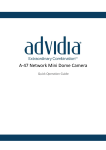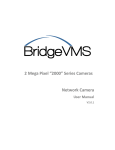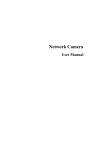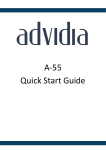Download User`s Manual - Ness Corporation
Transcript
104-588 3MP IP Vari-Focal VANDAL DOME CAMERA 104-589 3MP IP VANDAL DOME CAMERA 104-590 3MP IP IR BALL CAMERA 104-591 3MP IP Vari-Focal TUBE CAMERA Ness HD IP 3MP Network Camera Series User’s Manual REV 2.0 Network Camera User Manual V2.0.0 CAM1123M21 User Manual of Network Camera 1 Thank you for purchasing our product. If there are any questions, or requests, please do not hesitate to contact the dealer. This manual may contain several technical or printing errors, and the content is subject to change without notice. The updates will be added to the new version of this manual. We will readily improve or update the products or procedures described in the manual. DISCLAIMER STATEMENT “Underwriters Laboratories Inc. (“UL”) has not tested the performance or reliability of the security or signaling aspects of this product. UL has only tested for fire, shock or casualty hazards as outlined in UL’s Standard(s) for Safety, UL60950-1. UL Certification does not cover the performance or reliability of the security or signaling aspects of this product. UL MAKES NO REPRESENTATIONS, WARRANTIES OR CERTIFICATIONS WHATSOEVER REGARDING THE PERFORMANCE OR RELIABILITY OF ANY SECURITY OR SIGNALING RELATED FUNCTIONS OF THIS PRODUCT.” 0200001031127 User Manual of Network Camera 2 Regulatory Information FCC Information FCC compliance: This equipment has been tested and found to comply with the limits for a digital device, pursuant to part 15 of the FCC Rules. These limits are designed to provide reasonable protection against harmful interference when the equipment is operated in a commercial environment. This equipment generates, uses, and can radiate radio frequency energy and, if not installed and used in accordance with the instruction manual, may cause harmful interference to radio communications. Operation of this equipment in a residential area is likely to cause harmful interference in which case the user will be required to correct the interference at his own expense. FCC Conditions This device complies with part 15 of the FCC Rules. Operation is subject to the following two conditions: 1. This device may not cause harmful interference. 2. This device must accept any interference received, including interference that may cause undesired operation. EU Conformity Statement This product and - if applicable - the supplied accessories too are marked with "CE" and comply therefore with the applicable harmonized European standards listed under the Low Voltage Directive 2006/95/EC, the EMC Directive 2004/108/EC, the RoHS Directive 2011/65/EU. 2012/19/EU (WEEE directive): Products marked with this symbol cannot be disposed of as unsorted municipal waste in the European Union. For proper recycling, return this product to your local supplier upon the purchase of equivalent new equipment, or dispose of it at designated collection points. For more information see: www.recyclethis.info. 2006/66/EC (battery directive): This product contains a battery that cannot be disposed of as unsorted municipal waste in the European Union. See the product documentation for specific battery information. The battery is marked with this symbol, which may include lettering to indicate cadmium (Cd), lead (Pb), or mercury (Hg). For proper recycling, return the battery to your supplier or to a designated collection point. For more information see: www.recyclethis.info. User Manual of Network Camera 3 Safety Instruction These instructions are intended to ensure that the user can use the product correctly to avoid danger or property loss. The precaution measure is divided into ‘Warnings’ and ‘Cautions’: Warnings: Serious injury or death may be caused if any of these warnings are neglected. Cautions: Injury or equipment damage may be caused if any of these cautions are neglected. Warnings Follow these safeguards to Cautions Follow these precautions to prevent serious injury or death. prevent potential injury or material damage. Warnings: Please adopt the power adapter which can meet the safety extra low voltage (SELV) standard. And source with 24VAC10% or 12VDC10% (depending on models) according to the IEC60950-1 and Limited Power Source standard. The power consumption cannot be less than the required value. Do not connect several devices to one power adapter as an adapter overload may cause over-heating and can be a fire hazard. When the product is installed on a wall or ceiling, the device should be firmly fixed. To reduce the risk of fire or electrical shock, do not expose the indoor used product to rain or moisture. This installation should be made by a qualified service person and should conform to all the local codes. Please install blackouts equipment into the power supply circuit for convenient supply interruption. If the product does not work properly, please contact your dealer or the nearest service center. Never attempt to disassemble the product yourself. (We shall not assume any responsibility for problems caused by unauthorized repair or maintenance.) User Manual of Network Camera 4 Cautions: Make sure the power supply voltage is correct before using the product. Do not drop the product or subject it to physical shock. Do not install the product on vibratory surface or places. Do not expose it to high electromagnetic radiating environment. Do not aim the lens at the strong light such as sun or incandescent lamp. The strong light can cause fatal damage to the product. The sensor may be burned out by a laser beam, so when any laser equipment is being used, make sure that the surface of the sensor not be exposed to the laser beam. Do not place the product in extremely hot, cold temperatures (the operating temperature should be between -30°C ~ 65°C), dusty or damp environment. To avoid heat accumulation, good ventilation is required for a proper operating environment. While shipping, the product should be packed in its original packing. Please use the provided glove when open up the product cover. Do not touch the product cover with fingers directly, because the acidic sweat of the fingers may erode the surface coating of the product cover. Please use a soft and dry cloth when clean inside and outside surfaces of the product cover. Do not use alkaline detergents. Improper use or replacement of the battery may result in hazard of explosion. Please use the manufacturer recommended battery type. User Manual of Network Camera 5 Table of Contents Chapter 1 System Requirement......................................................................................... 6 Chapter 2 Network Connection ......................................................................................... 7 2.1 SETTING THE NETWORK CAMERA OVER THE LAN ................................................................................ 7 2.1.1 2.2 Wiring over the LAN ............................................................................................................. 7 SETTING THE NETWORK CAMERA OVER THE WAN .............................................................................. 8 2.2.2 Static IP Connection ............................................................................................................. 8 2.2.3 Dynamic IP Connection ........................................................................................................ 9 Chapter 3 3.1 Access to the Network Camera....................................................................... 11 ACCESSING BY WEB BROWSERS ..................................................................................................... 11 Chapter 4 Live View ......................................................................................................... 13 4.1 LIVE VIEW PAGE ......................................................................................................................... 13 4.2 STARTING LIVE VIEW ................................................................................................................... 14 4.3 RECORDING AND CAPTURING PICTURES MANUALLY ........................................................................... 14 Chapter 5 Network Camera Configuration ................................................................... 15 5.1 CONFIGURING TIME SETTINGS ....................................................................................................... 15 5.2 CONFIGURING NETWORK SETTINGS ................................................................................................ 17 5.2.1 Configuring TCP/IP Settings ............................................................................................... 17 5.2.2 Configuring Port Settings ................................................................................................... 17 5.2.3 Configuring DDNS Settings ................................................................................................ 18 5.2.4 Configuring SNMP Settings ................................................................................................ 19 5.2.5 Configuring FTP Settings .................................................................................................... 21 5.2.6 Configuring UPnP™ Settings .............................................................................................. 22 5.2.7 Configuring Email Settings ................................................................................................. 22 5.2.8 Configuring NAT (Network Address Translation) Settings .................................................. 24 5.3 5.3.1 5.4 CONFIGURING VIDEO AND AUDIO SETTINGS ..................................................................................... 25 Configuring Video Settings ................................................................................................ 25 CONFIGURING IMAGE PARAMETERS ................................................................................................ 26 5.4.1 Configuring Display Settings .............................................................................................. 26 5.4.2 Configuring OSD Settings ................................................................................................... 29 5.4.3 Configuring Text Overlay Settings ...................................................................................... 30 5.4.4 Configuring Privacy Mask .................................................................................................. 31 User Manual of Network Camera 6 Chapter 1 System Requirement Operating System: Microsoft Windows XP SP1 and above version / Vista / Win7 / Server 2003 / Server 2008 32bits CPU: Intel Pentium IV 3.0 GHz or higher RAM: 1G or higher Display: 1024×768 resolution or higher Web Browser: Internet Explorer 6.0 and above version, Apple Safari 5.02 and above version, Mozilla Firefox 3.5 and above version and Google Chrome8 and above versions. User Manual of Network Camera 7 Chapter 2 Network Connection Before you start: If you want to set the network camera via a LAN (Local Area Network), please refer to Section 2.1 Setting the Network Camera over the LAN. If you want to set the network camera via a WAN (Wide Area Network), please refer to Section 2.2 Setting the Network Camera over the WAN. 2.1 Setting the Network Camera over the LAN Purpose: To view and configure the camera via a LAN, you need to connect the network camera in the same subnet with your computer, and install the IP-Installer software to search and change the IP of the network camera. 2.1.1 Wiring over the LAN The following figures show the two ways of cable connection of a network camera and a computer: Purpose: Refer to the Figure 2-1 to set the network camera over the LAN via a switch or a router. Figure 2-1 Connecting via a Switch or a Router User Manual of Network Camera 8 2.2 Setting the Network Camera over the WAN Purpose: This section explains how to connect the network camera to the WAN with a static IP or a dynamic IP. 2.2.2 Static IP Connection Before you start: Please apply a static IP from an ISP (Internet Service Provider). With the static IP address, you can connect the network camera via a router or connect it to the WAN directly. Connecting the network camera via a router Steps: 1. Connect the network camera to the router. 2. Assign a LAN IP address, the subnet mask and the gateway. 3. Save the static IP in the router. 4. Set port mapping, e.g., 80, 8000, 8200 and 554 ports. The steps for port mapping vary depending on different routers. Please call the router manufacturer for assistance with port mapping. 5. Visit the network camera through a web browser or the client software over the internet. Figure 2-2 Accessing the Camera through Router with Static IP User Manual of Network Camera 9 Connecting the network camera with static IP directly You can also save the static IP in the camera and directly connect it to the internet without using a router. Figure 2-3 Accessing the Camera with Static IP Directly 2.2.3 Dynamic IP Connection Before you start: Please apply a dynamic IP from an ISP. With the dynamic IP address, you can connect the network camera to a modem or a router. Connecting the network camera via a router Steps: 1. Connect the network camera to the router. 2. In the camera, assign a LAN IP address, the subnet mask and the gateway. 3. Set port mapping. E.g. 80, 8000, 8200 and 554 ports. The steps for port mapping vary depending on different routers. Please call the router manufacturer for assistance with port mapping. 4. Apply a domain name from a domain name provider. 5. Configure the DDNS settings in the setting interface of the router. 6. Visit the camera via the applied domain name. Figure 2-4 Accessing the Camera with Dynamic IP User Manual of Network Camera 10 Normal Domain Name Resolution Figure 2-5 Normal Domain Name Resolution Steps: 1. Apply a domain name from a domain name provider. 2. Configure the DDNS settings in the DDNS Settings interface of the network camera.. 3. Visit the camera via the applied domain name. Private Domain Name Resolution Figure 2-6 Private Domain Name Resolution Steps: 1. Install and run the IP Server software in a computer with a static IP. 2. Access the network camera through the LAN with a web browser or the client software. 3. Enable DDNS and select IP Server as the protocol type. Chapter 3 Access to the Network Camera 3.1 Accessing by Web Browsers Steps: 1. Open the web browser. 2. In the address field, input the IP address of the network camera, e.g., 192.0.0.64 and hit the enter key to enter the login interface. 3. Input the user name and password and click Login. The default user name is admin, and the password is 1111. Users can search IP address of Camera via Onvif Device Manager or IP-Installer Figure 3-1 Login Interface 4. Install the plug-in before viewing the live video and operating the camera. Please follow the installation prompts to install the plug-in. User Manual of Network Camera Figure 3-2 Download and Install Plug-in Figure 3-3 Install Plug-in (1) Figure 3-4 Install Plug-in (2) 12 13 User Manual of Network Camera You may have to close the web browser to install the plug-in. Please reopen the web browser and log in again after the plug-in is installed. Chapter 4 Live View 4.1 Live View Page Purpose: The live video page allows you to view live video, capture images, realize PTZ control, set/call presets and configure video parameters. Log in the network camera to enter the live view page, or you can click the menu bar of the main page to enter the live view page. Descriptions of the live view page: Figure 4-1 Live View Page Menu Bar: Click each tab to enter Live View, Playback, Log and Configuration interface. Display Control: Click each tab to adjust the layout and the stream type of the live view. Live View Window: Display the live view. on 14 User Manual of Network Camera Toolbar: Operations on the live view page, e.g., live view, capture, record, audio on/off, two-way audio, etc. 4.2 Starting Live View In the live view window as shown in Figure 4-2, click on the toolbar to start the live view of the camera. Figure 4-2 Live View Toolbar Table 4-1 Descriptions of the Toolbar Icon Description Start/Stop live view / Manually capture the pictures displayed in live view and then save it as a JPEG file or BMP file. / Manually start/stop recording. Audio on and adjust volume /Mute. / / Enable/Disable two-way audio. Enable/Disable e-PTZ. Full-screen Mode You can double-click on the live video to switch the current live view into full-screen or return to normal mode from the full-screen. 4.3 Recording and Capturing Pictures Manually In the live view interface, click to record the live video. on the toolbar to capture the live pictures or click 15 User Manual of Network Camera The captured image will be saved as JPEG or BMP file in your computer. Chapter 5 Network Camera Configuration 5.1 Configuring Time Settings Purpose: You can follow the instructions in this section to configure the time synchronization and DST settings. Steps: 1. Enter the Time Settings interface: Configuration > Advanced Configuration > System > Time Settings Figure 5-1 Time Settings Select the Time Zone. Select the Time Zone which is the closest to the location of the camera from the drop-down menu. Synchronizing Time by NTP Server. (1) Check the checkbox to enable the NTP function. (2) Configure the following settings: Server Address: IP address of NTP server. NTP Port: Port of NTP server. 16 User Manual of Network Camera Interval: The time interval between the two synchronizing actions with NTP server. Figure 5-2 Time Sync by NTP Server If the camera is connected to a public network, you should use a NTP server that has a time synchronization function, such as the server at the National Time Center (IP Address: 210.72.145.44). If the camera is set in a customized network, NTP software can be used to establish a NTP server for time synchronization. Synchronizing Time Synchronization Manually Enable the Manual Time Sync function and then click from the pop-up calendar. to set the system time You can also check the Sync with computer time checkbox to synchronize the time of the camera with that of your computer. Figure 5-3 Time Sync Manually Click tab to enable the DST function and Set the date of the DST period. Figure 5-4 DST Settings 2. Click Save to save the settings. User Manual of Network Camera 17 5.2 Configuring Network Settings 5.2.1 Configuring TCP/IP Settings Purpose: TCP/IP settings must be properly configured before you operate the camera over network. The camera supports both the IPv4 and IPv6. Both versions may be configured simultaneously without conflicting to each other, and at least one IP version should be configured. Steps: 1. Enter TCP/IP Settings interface: Configuration > Advanced Configuration > Network > TCP/IP Figure 5-5 TCP/IP Settings 5.2.2 Configuring Port Settings Purpose: You can set the port No. of the camera, e.g. HTTP port, RTSP port and HTTPS port. User Manual of Network Camera 18 Steps: 1. Enter the Port Settings interface: Configuration > Advanced Configuration > Network > Port Figure 5-6 Port Settings 2. Set the HTTP port, RTSP port and HTTPS port of the camera. HTTP Port: The default port number is 80, and can be changed to any port range 1024 to 65535. RTSP Port: The default port number is 554. HTTPS Port: The default port number is 443, and can be changed to any port range 1024 to 65535. Server Port: The default server port number is 8000. 3. Click Save to save the settings. A reboot is required for the settings to take effect. 5.2.3 Configuring DDNS Settings Purpose: If your camera is set to use PPPoE as its default network connection, you can use the Dynamic DNS (DDNS) for network access. Before you start: Registration on the DDNS server is required before configuring the DDNS settings of the camera. Steps: 1. Enter the DDNS Settings interface: Configuration > Advanced Configuration > Network > DDNS User Manual of Network Camera 19 Figure 5-7 DDNS Settings 2. Check the Enable DDNS checkbox to enable this feature. Select DDNS Type. 5.2.4 Configuring SNMP Settings Purpose: You can set the SNMP function to get camera status, parameters and alarm related information and manage the camera remotely when it is connected to the network. Before you start: Before setting the SNMP, please download the SNMP software and manage to receive the camera information via SNMP port. By setting the Trap Address, the camera can send the alarm event and exception messages to the surveillance center. The SNMP version you select should be the same as that of the SNMP software. And you also need to use the different version according to the security level you required. SNMP v1 provides no security and SNMP v2 requires password for access. And SNMP v3 provides encryption and if you use the third version, HTTPS protocol must be enabled. Steps: 1. Enter the SNMP Settings interface: Configuration > Advanced Configuration > Network > SNMP 20 User Manual of Network Camera Figure 5-8 SNMP Settings 2. Check the corresponding version checkbox ( , , ) to enable the feature. 3. Configure the SNMP settings. The settings of the SNMP software should be the same as the settings you configure here. 4. Click Save to save and finish the settings. A reboot is required for the settings to take effect. 21 User Manual of Network Camera 5.2.5 Configuring FTP Settings Purpose: You can configure the FTP server related information to enable the uploading of the captured pictures to the FTP server. The captured pictures can be triggered by events or a timing snapshot task. Steps: 1. Enter the FTP Settings interface: Configuration >Advanced Configuration > Network > FTP Figure 5-9 FTP Settings 2. Configure the FTP settings; and the user name and password are required for login the FTP server. Directory: In the Directory Structure field, you can select the root directory, parent directory and child directory. When the parent directory is selected, you have the option to use the Device Name, Device Number or Device IP for the name of the directory; and when the Child Directory is selected, you can use the Camera Name or Camera No. as the name of the directory. Upload type: To enable uploading the captured picture to the FTP server. Anonymous Access to the FTP Server (in which case the user name and password won’t be requested.): Check the checkbox to enable the anonymous access to the FTP server. The anonymous access function must be supported by the FTP server. 3. Click Save to save the settings. User Manual of Network Camera 22 If you want to upload the captured pictures to FTP server, you have to enable the continuous snapshot or event-triggered snapshot on Snapshot page.. 5.2.6 Configuring UPnP™ Settings Universal Plug and Play (UPnP™) is a networking architecture that provides compatibility among networking equipment, software and other hardware devices. The UPnP protocol allows devices to connect seamlessly and to simplify the implementation of networks at home and in corporate environments. With the function enabled, you don’t need to configure the port mapping for each port, and the camera is connected to the Wide Area Network via the router. Steps: 1. Enter the UPnP™ settings interface. Configuration >Advanced Configuration > Network > UPnP 2. Check the checkbox to enable the UPnP™ function. The name of the device when detected online can be edited. Figure 5-10 Configure UPnP Settings 5.2.7 Configuring Email Settings The system can be configured to send an Email notification to all designated receivers if an alarm event is detected, e.g., motion detection event, video loss, video tampering, etc. Before you start: Please configure the DNS Server settings under Advanced Configuration > Network > TCP/IP before using the Email function. User Manual of Network Camera 23 Steps: 1. Enter the TCP/IP Settings (Configuration > Advanced Configuration > Network > TCP/IP) to set the IPv4 Address, IPv4 Subnet Mask, IPv4 Default Gateway and the Preferred DNS Server. 2. Enter the Email Settings interface: Configuration > Advanced Configuration > Network > Email Figure 5-11 Email Settings 3. Configure the following settings: Sender: The name of the email sender. Sender’s Address: The email address of the sender. SMTP Server: The SMTP Server IP address or host name (e.g., smtp.263xmail.com). SMTP Port: The SMTP port. The default TCP/IP port for SMTP is 25 (not secured). And the SSL SMTP port is 465. Enable SSL: Check the checkbox to enable SSL if it is required by the SMTP server. User Manual of Network Camera 24 Attached Image: Check the checkbox of Attached Image if you want to send emails with attached alarm images. Interval: The interval refers to the time between two actions of sending attached pictures. Authentication (optional): If your email server requires authentication, check this checkbox to use authentication to log in to this server and enter the login user Name and password. Choose Receiver: Select the receiver to which the email is sent. Up to 2 receivers can be configured. Receiver: The name of the user to be notified. Receiver’s Address: The email address of user to be notified. 4. Click Save to save the settings. 5.2.8 Configuring NAT (Network Address Translation) Settings 1. Enter the NAT settings interface. Configuration >Advanced Configuration > Network > NAT 2. Choose the port mapping mode. To port mapping with the default port number, you can choose Port Mapping Mode as Auto. To port mapping with the customized port numbers, you can choose Port Mapping Mode as Manual. And for manual port mapping, you can customize the value of the port number by yourself. Figure 5-12 Configure NAT Settings User Manual of Network Camera 25 3. Click Save to save the settings. 5.3 Configuring Video and Audio Settings 5.3.1 Configuring Video Settings Steps: 1. Enter the Video Settings interface: Configuration > Advanced Configuration > Video / Audio > Video Figure 5-13 Configure Video Settings 2. Select the Stream Type of the camera to main stream (normal), sub-stream or third stream. The main stream is usually for recording and live viewing with good bandwidth, and the sub-stream and third stream can be used for live viewing when the bandwidth is limited. 3. You can customize the following parameters for the selected main stream or sub-stream: Video Type: Select the stream type to video stream, or video & audio composite stream. The audio signal will be recorded only when the Video Type is Video & Audio. Resolution: Select the resolution of the video output. Bitrate Type: Select the bitrate type to constant or variable. User Manual of Network Camera 26 Video Quality: When bitrate type is selected as Variable, 6 levels of video quality are selectable. Frame Rate: Set the frame rate to 1/16~30 fps. The frame rate is to describe the frequency at which the video stream is updated and it is measured by frames per second (fps). A higher frame rate is advantageous when there is movement in the video stream, as it maintains image quality throughout. Max. Bitrate: Set the max. bitrate to 32~16384 Kbps. The higher value corresponds to the higher video quality, but the higher bandwidth is required. Video Encoding: If the Stream Type is set to main stream, H.264 is selectable, and if the stream type is set to sub stream, H.264, and MJPEG are selectable. The supported video encoding may differ according to the different platform. I Frame Interval: Set the I-Frame interval to 1~400. 4. Click Save to save the settings. 5.4 Configuring Image Parameters 5.4.1 Configuring Display Settings Purpose: You can set the image quality of the camera, including brightness, contrast, saturation, hue, sharpness, etc. The Display parameters vary depending on the camera model. Steps: 1. Enter the Display Settings interface: Configuration > Advanced Configuration> Image> Display Settings User Manual of Network Camera 27 2. Set the image parameters of the camera. Figure 5-14 Display Settings Descriptions of parameter configuration Overexposure Prevention: Enable or disable the function in this field. Exposure Time: Value ranges from 1/25 to 1/100,000s. Adjust it according to the lightening condition. Iris Mode: Auto and Manual are selectable. Auto Iris Level: If you choose the auto iris mode, you can set the auto iris level. Video Standard: 50 Hz and 60 Hz are selectable. Choose according to the different video standards; normally 50Hz for PAL standard and 60Hz for NTSC standard. Day/Night Switch: Day, Night and Auto are selectable. Sensitivity: If you choose auto day/night switch, you can choose the sensitivity of the switch as high, normal and low. User Manual of Network Camera 28 Mirror: The mirror function enables you to view another aspect of the image. You can flip the image horizontally and vertically. It can be used to view the image in the way you see it directly using your eyes. WDR: Wide dynamic range can be used when there is a high contrast of the bright area and the dark area of the scene. BLC Area: BLC area is the area sense the light intensity; Close, Up, Down, Left, Right and Center are selectable. White Balance: The below figure shows the white balance type selectable. You can choose it according to the real condition. For example, if in the surveillance scene, there is a fluorescent lamp, you can choose the white balance type as the Fluorescent Lamp. Figure 5-15 White Balance Digital Noise Reduction: Close, Normal Mode and Expert Mode are selectable. Noise Reduction Level: For adjusting the noise reduction level and only valid when the DNR function is enabled. Scene Mode: Choose the scene as indoor or outdoor. HLC: High light compression function can be used when there are strong lights in the scene which affect the image quality. Grey Scale: You can choose the range of the grey scale as [0-255] or [16-235]. Corridor mode: To make a complete use of the 16:9 aspect ratio, you can enable the corridor mode User Manual of Network Camera 29 when you use the camera in a narrow view scene. When installing, turn the camera to the 90 degrees or rotate the 3-axis lens to 90 degrees, and set the corridor mode as on, you will get a normal view of the scene with 9:16 aspect ratio to ignore the needless information such as the wall, and get more meaningful information of the scene. 5.4.2 Configuring OSD Settings Purpose: You can customize the camera name and time on the screen. Steps: 1. Enter the OSD Settings interface: Configuration > Advanced Configuration > Image > OSD Settings Figure 5-16 OSD Settings 2. Check the corresponding checkbox to select the display of camera name, date or week if required. 3. Edit the camera name in the text field of Camera Name. 4. Select from the drop-down list to set the time format, date format, display mode and the OSD font size. 5. You can use the mouse to click and drag the text frame view window to adjust the OSD position. in the live 30 User Manual of Network Camera Figure 5-17 Adjust OSD Location 6. Click Save to activate above settings. 5.4.3 Configuring Text Overlay Settings You can customize the text overlay. Steps: 1. Enter the Text Overlay Settings interface: Configuration > Advanced Configuration > Image > Text Overlay 2. Check the checkbox in front of textbox to enable the on-screen display. 3. Input the characters in the textbox. 4. Use the mouse to click and drag the red text frame window to adjust the text overlay position. 5. Click Save. Up to 4 text overlays are configurable. in the live view User Manual of Network Camera 31 Figure 5-18 Text Overlay Settings 5.4.4 Configuring Privacy Mask Purpose: Privacy mask enables you to cover certain areas on the live video to prevent certain spots in the surveillance area from being live viewed and recorded. Steps: 1. Enter the Privacy Mask Settings interface: Configuration > Advanced Configuration> Image > Privacy Mask 2. Check the checkbox of Enable Privacy Mask to enable this function. 3. Click . 32 User Manual of Network Camera Figure 5-19 Privacy Mask Settings 4. Click and drag the mouse in the live video window to draw the mask area. You are allowed to draw up to 4 areas on the same image. 5. (Optional) click to clear all of the areas you set without saving them. 6. Click Save to save the settings.











































